Home > Historical Heritage Tours > Kingdom of the Dragon and Lion > < Day 5 ….. Day 7 >
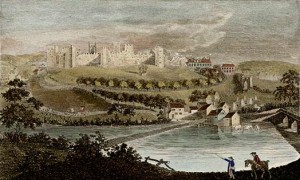 The sixth day of our tour along the Welsh Marches begins with a visit to the town of Ludlow and in particular its impressively situated Ludlow Castle which was the most important within the Marche lands during the Norman and Medieval period. Built on a defensive position upon a rocky outcrop around which the River Teme loops, the castle was the stronghold of Roger De Lacy who was one of the border lords who kept the border secure for the English Crown. Much of de Lacy’s original keep and bailey survives, although additional alterations have been made over the centuries as the castle grew to be the most important in the Welsh Borders. Its Elizabethan buildings, once served the Council of the Marches, a body that was set up to govern Wales and all of the border counties.The town of Ludlow grew with the castle and subsequently became a prosperous market town trading in both wool and cloth and an important centre for trade between England and Wales. This prosperity is reflected in the many fine examples of Tudor and Georgian architecture that can be seen, including the famous Feathers Inn situated the centre of town with it’s elaborately carved wooden facade.
The sixth day of our tour along the Welsh Marches begins with a visit to the town of Ludlow and in particular its impressively situated Ludlow Castle which was the most important within the Marche lands during the Norman and Medieval period. Built on a defensive position upon a rocky outcrop around which the River Teme loops, the castle was the stronghold of Roger De Lacy who was one of the border lords who kept the border secure for the English Crown. Much of de Lacy’s original keep and bailey survives, although additional alterations have been made over the centuries as the castle grew to be the most important in the Welsh Borders. Its Elizabethan buildings, once served the Council of the Marches, a body that was set up to govern Wales and all of the border counties.The town of Ludlow grew with the castle and subsequently became a prosperous market town trading in both wool and cloth and an important centre for trade between England and Wales. This prosperity is reflected in the many fine examples of Tudor and Georgian architecture that can be seen, including the famous Feathers Inn situated the centre of town with it’s elaborately carved wooden facade.
Whilst in Ludlow we will visit the churchyard where the famous poet A E Housman was laid to rest.  A cherry tree stump marks the spot and a plaque was placed on the north wall of the church. A new cherry tree has subsequently been planted by the Housman Society to the west of the church. The second poem of “A Shropshire Lad”
A cherry tree stump marks the spot and a plaque was placed on the north wall of the church. A new cherry tree has subsequently been planted by the Housman Society to the west of the church. The second poem of “A Shropshire Lad” 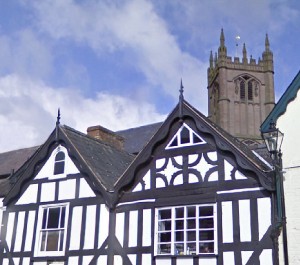 famously describes a cherry tree: ‘Loveliest of trees, the cherry now/Is hung with bloom along the bough,’ As a poet, Housman is chiefly remembered for the wistful and metrical poems of A Shropshire Lad (1896) which he originally published at his own expense. Housman was not a native of Shropshire but originally came from Worcestershire. However, Shropshire became an imaginary landscape for him with his poetry presenting a lyrical and nostalgic view of English country life which is underpinned by a deep sense of longing and foreboding. “Into my heart an air that kills, From yon far country blows, What are those blue remembered hills, What spires, what farms are those? That is the land of lost content, I see it shining plain, The happy highways where I went And cannot come again. From the poem “A Shropshire Lad” http://www.housman-society.co.uk/
famously describes a cherry tree: ‘Loveliest of trees, the cherry now/Is hung with bloom along the bough,’ As a poet, Housman is chiefly remembered for the wistful and metrical poems of A Shropshire Lad (1896) which he originally published at his own expense. Housman was not a native of Shropshire but originally came from Worcestershire. However, Shropshire became an imaginary landscape for him with his poetry presenting a lyrical and nostalgic view of English country life which is underpinned by a deep sense of longing and foreboding. “Into my heart an air that kills, From yon far country blows, What are those blue remembered hills, What spires, what farms are those? That is the land of lost content, I see it shining plain, The happy highways where I went And cannot come again. From the poem “A Shropshire Lad” http://www.housman-society.co.uk/
From Ludlow we travel into the county of Herefordshire and Croft Castle at Yarpole. This magnificent 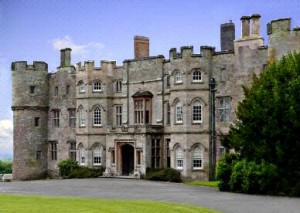 castle has been the home of the Croft family almost continuously since the time of William the Conqueror in the late 11th century although the building itself was significantly refurbished in the 15th Century. The Castle has particularly fine interiors containing many good examples of period furnishings and paintings, including works by Gainsborough and Lawrence. Within the grounds there are restored walled gardens, a kitchen garden and park with a magnificent avenue of 350 year old Spanish chestnut trees and panoramas which stretch across the surrounding countryside.
castle has been the home of the Croft family almost continuously since the time of William the Conqueror in the late 11th century although the building itself was significantly refurbished in the 15th Century. The Castle has particularly fine interiors containing many good examples of period furnishings and paintings, including works by Gainsborough and Lawrence. Within the grounds there are restored walled gardens, a kitchen garden and park with a magnificent avenue of 350 year old Spanish chestnut trees and panoramas which stretch across the surrounding countryside.
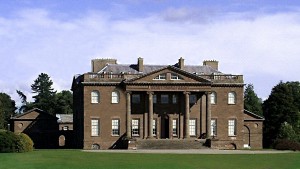 From Croft we journey through some of the most pastoral scenery seen during the tour on our way to nearby Berrington Hall. This house is notable for the part the famous English landscape architect Capability Brown had on its development. In the 18th century Thomas Harley made a fortune supplying the British army with clothing and pay. When Harley decided he needed a new house to showcase his family’s prestige and wealth, he called upon Capability Brown, who’s work at creating parkland around large country houses had brought him considerable fame and fortune. It was Capability Brown who chose the location for Berrington Hall, selecting a site that gave sweeping views to the Black Mountains of Wales. While Brown busied himself with creating the parkland and semi-natural landscapes for which he was famous, the task of building the house itself fell to Brown’s son in law, architect Henry Holland. Holland began work in 1778 and the house was
From Croft we journey through some of the most pastoral scenery seen during the tour on our way to nearby Berrington Hall. This house is notable for the part the famous English landscape architect Capability Brown had on its development. In the 18th century Thomas Harley made a fortune supplying the British army with clothing and pay. When Harley decided he needed a new house to showcase his family’s prestige and wealth, he called upon Capability Brown, who’s work at creating parkland around large country houses had brought him considerable fame and fortune. It was Capability Brown who chose the location for Berrington Hall, selecting a site that gave sweeping views to the Black Mountains of Wales. While Brown busied himself with creating the parkland and semi-natural landscapes for which he was famous, the task of building the house itself fell to Brown’s son in law, architect Henry Holland. Holland began work in 1778 and the house was 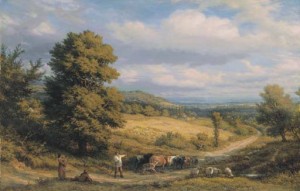 completed in 1783. He drew upon the popular neo-classical style of the time to create a house with two very different characters. Outside, the red sandstone of Berrington Hall presents a stiff, formal picture, the most notable aspect of which is the massive front portico. But if the exterior is plain, sparingly adorned, the interior is a riot of lavish colour and ornate decoration. Here the decoration is unrestrained, with wonderful painted ceilings, ornate plasterwork, and a high dome shedding light onto a spectacular entry staircase. The elegant Georgian theme is augmented by fine furniture most of it French. Lord Admiral Rodney was a family friend and visited Berrington Hall frequently. The dining room is hung with huge paintings by Luny depicting Rodney’s famous sea battles. Unsurprisingly given Capability Brown’s close involvement in Berrington the house is surrounded by some of the best landscaped parkland seen in England, with carefully arranged trees and shrubs planted to create a pastoral landscape which blends with the surrounding countryside but still retaining degree of restrained formality. The walled garden contain rare species of old fruit trees; apple, plum, cherry, and many more.
completed in 1783. He drew upon the popular neo-classical style of the time to create a house with two very different characters. Outside, the red sandstone of Berrington Hall presents a stiff, formal picture, the most notable aspect of which is the massive front portico. But if the exterior is plain, sparingly adorned, the interior is a riot of lavish colour and ornate decoration. Here the decoration is unrestrained, with wonderful painted ceilings, ornate plasterwork, and a high dome shedding light onto a spectacular entry staircase. The elegant Georgian theme is augmented by fine furniture most of it French. Lord Admiral Rodney was a family friend and visited Berrington Hall frequently. The dining room is hung with huge paintings by Luny depicting Rodney’s famous sea battles. Unsurprisingly given Capability Brown’s close involvement in Berrington the house is surrounded by some of the best landscaped parkland seen in England, with carefully arranged trees and shrubs planted to create a pastoral landscape which blends with the surrounding countryside but still retaining degree of restrained formality. The walled garden contain rare species of old fruit trees; apple, plum, cherry, and many more.
 The remainder of the day is spent exploring the nearby cathedral town of Hereford. Situated on the River Wye in the centre of this rural county. The city dates from the 7th century AD when it was an important fording point of the River. Like many Welsh Border towns, Hereford’s strategic position on the River Wye made it important in terms of both trade and warfare whilst it also functioned as an important administrative and processing centre for the rural county of Herefordshire, which is known for soft fruit and cider production, and the world famous Hereford cattle breed. The Hereford Cathedral dates from 1079 AD, making it one of the oldest in England and contains the Mappa Mundi, a medieval
The remainder of the day is spent exploring the nearby cathedral town of Hereford. Situated on the River Wye in the centre of this rural county. The city dates from the 7th century AD when it was an important fording point of the River. Like many Welsh Border towns, Hereford’s strategic position on the River Wye made it important in terms of both trade and warfare whilst it also functioned as an important administrative and processing centre for the rural county of Herefordshire, which is known for soft fruit and cider production, and the world famous Hereford cattle breed. The Hereford Cathedral dates from 1079 AD, making it one of the oldest in England and contains the Mappa Mundi, a medieval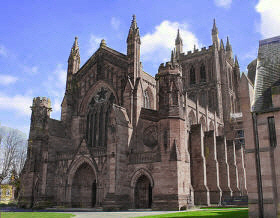 map of the world dating from the 13th century restored in the late 20th century. It also contains the world famous Chained Library. Another impressive Medieval structure is the Wye bridge, which crosses the river on the southern side of the City. This beautiful ashlar faced bridge actually dates back as far as the 13th century and when viewed looking towards the cathedral present a particularly splendid vista which has remained unchanged for centuries. You will find that beautiful vistas are not unusual to see during our tour, and a visit to the Hereford museum and art gallery will demonstrate how this part of the Welsh Borders has been the source of inspiration for artists in the past as well as the present.
map of the world dating from the 13th century restored in the late 20th century. It also contains the world famous Chained Library. Another impressive Medieval structure is the Wye bridge, which crosses the river on the southern side of the City. This beautiful ashlar faced bridge actually dates back as far as the 13th century and when viewed looking towards the cathedral present a particularly splendid vista which has remained unchanged for centuries. You will find that beautiful vistas are not unusual to see during our tour, and a visit to the Hereford museum and art gallery will demonstrate how this part of the Welsh Borders has been the source of inspiration for artists in the past as well as the present.
Day 6 Highlights:
- Ludlow
- Ludlow Castle
- Feathers Inn
- Churchyard where A. E. Housman is buried
- Croft Castle
- Berrington Hall
- Hereford
- Hereford Cathedral
- Mappa Mundi
- Chained Library
- River Wye bridge
- Hereford Museum and Art Gallery-




